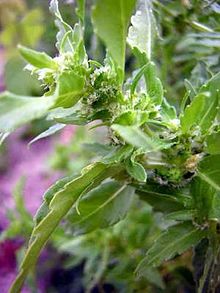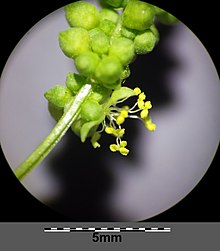Annual ringelkraut
| Annual ringelkraut | ||||||||||||
|---|---|---|---|---|---|---|---|---|---|---|---|---|

Annual ringwort ( Mercurialis annua ), female (left) and male (right) plant |
||||||||||||
| Systematics | ||||||||||||
|
||||||||||||
| Scientific name | ||||||||||||
| Mercurialis annua | ||||||||||||
| L. |
The annual ringelkraut ( Mercurialis annua ) is a species of the genus Bingelkräuter ( Mercurialis ), which contains no milky sap, within the family of the milkweed family (Euphorbiaceae).
description
Vegetative characteristics
The annual bingelkraut grows as an annual herbaceous plant that reaches stature heights of 20 to 50, mostly about 30 centimeters. In contrast to Euphorbia species, the plant has no milky sap . The completely bare plants are usually leafy and branched along their entire length, with the branches usually stiffly sloping upwards. The stem is more or less square. The entire plant is light green to grass green, while the similar forest ringelkraut is more dark green. The leaves are narrowly ovate to lanceolate and bluntly serrate on the edge. Female plants have narrower leaves than males.
Generative characteristics
The annual bingelkraut is mostly, but not always dioecious, separate sexes ( diocesan ). The flowers of the male plants sit, mostly arranged in small clusters, in axillary spikes , which, however, protrude far beyond the leaves. The inflorescences are slightly longer and more flowered than those of the forest ringelkraut. In the female plants, the flowers sit in small clusters in the leaf axils. The single flowers are inconspicuous greenish-yellowish and have three bracts .
The flowering period begins in Central Europe in June and continues into autumn. Fruit ripening begins in July.
The number of chromosomes is 2n = 16.
ecology
The annual ringelkraut is a therophyte , which in Central Europe often forms two generations per year. The plant is sensitive to frost. The annual ringelkraut shows sexual dimorphism , i. H. the sexes are clearly different. The plant has roots up to 50 centimeters deep.
Mostly wind pollination takes place , but insect pollination also occurs. The sepals inside an erectile tissue in their sudden, explosive opening the tear dust bag , and be thrown out. The considerable number of 1.3 billion pollen grains was calculated per plant. Pollen putty is available, the pollen grains are spread individually or in clumps depending on the wind.
The botanist and physician RJ Camerarius (1665–1721) in Tübingen determined in 1694, using the example of the bingelwort, through the separate cultivation of male and female plants, that without the opposite sex there would be no seed set. Before him, however, the ancient Greek Theophrastus had already suspected the same thing for the date palm .
The annual ringelkraut is a dehydration spreader, its fruit capsules open by a "pushing mechanism", the seeds are thrown away up to 4 meters. Ants spread the seeds further . The seeds are long-lasting heat germs. Also apomixis , ie seed formation without fertilization was observed.
Occurrence
The annual ringelkraut originally comes from the Mediterranean area . It has been naturalized in Central Europe and north to Scandinavia since the 16th century . It is a neophyte in some areas of North America .
It grows mainly in nitrogen-rich, loamy and not too dry ruderal areas , for example as weeds in gardens or on fields, or on rubble sites . It is widespread in Central Europe , except in the Alps . It is not uncommon in nutrient-rich ruderal spots . In Central Europe it is a character species of the Mercurialetum annuae from the Fumario-Euphorbion association, nationally it is a character species of the class Chenopodietea. In the Vosges, the species rises to 1030 meters above sea level.
Taxonomy
The first publication of Mercurialis annua was in 1753 by Carl von Linné in Species Plantarum .
Medical importance
Medicinal plant
In ancient times and in the Middle Ages , dried plants of the annual bingelkweed were used as a medicinal plant, especially against gynecological problems and digestive problems (such as stomach constipation). Bingelkraut was seen as a means to quickly stimulate menstrual bleeding, and it was also used for eye problems and blocked ear canals.
Toxicity
In contrast, the fresh bingelkraut is slightly poisonous and can possibly lead to poisoning in grazing cattle.
swell
literature
- Henning Haeupler, Thomas Muer: picture atlas of the fern and flowering plants of Germany . Ed .: Federal Agency for Nature Conservation (= The fern and flowering plants of Germany . Volume 2 ). Eugen Ulmer, Stuttgart (Hohenheim) 2000, ISBN 3-8001-3364-4 .
- Rudolf Schubert , Klaus Werner, Hermann Meusel (eds.): Excursion flora for the areas of the GDR and the FRG . Founded by Werner Rothmaler. 14th edition. tape 2 : vascular plants . People and knowledge, Berlin 1988, ISBN 3-06-012539-2 .
- Werner Rauh, Karlheinz Senghas: Flora of Germany and its adjacent areas. Founded by Otto Schmeil, Jost Fitschen. 84th edition. Quelle & Meyer, Heidelberg 1968.
Individual evidence
- ↑ a b c d e f g Ruprecht Düll , Herfried Kutzelnigg : Pocket dictionary of plants in Germany and neighboring countries. The most common Central European species in portrait . 7th, corrected and enlarged edition. Quelle & Meyer, Wiebelsheim 2011, ISBN 978-3-494-01424-1 , p. 505-506 .
- ↑ a b c d Erich Oberdorfer : Plant-sociological excursion flora for Germany and neighboring areas . 8th edition. Verlag Eugen Ulmer, Stuttgart 2001, ISBN 3-8001-3131-5 . Page 634.
- ↑ Carl von Linné: Species Plantarum. Volume 2, Lars Salvius, Stockholm 1753, p. 1035 ( digitized ).
- ↑ Hans Zotter : Ancient medicine. The collective medical manuscript Cod. Vindobonensis 93 in Latin and German. Academic printing and Verlagsanstalt, Graz 1980 (= Interpretationes ad codices. Volume 2); 2nd, improved edition, ibid. 1986, ISBN 3-201-01310-2 , p. 150 f. (to the plant Mercurialis )
- ^ Lutz Roth, Max Daunderer, Kurt Kormann: Toxic Plants - Plant Poisons. Occurrence, effect, therapy, allergic and phototoxic reactions; new: with a special section on poisonous animals. 5th expanded edition. Nikol, Hamburg 2008, ISBN 978-3-86820-009-6 , pp. 495-496.
Web links
- Annual ringelkraut. In: FloraWeb.de.
- Distribution map for Germany. In: Floraweb .
- Mercurialis annua L. In: Info Flora , the national data and information center for Swiss flora .
- Distribution in the northern hemisphere from: Eric Hultén, Magnus Fries: Atlas of North European vascular plants. 1986, ISBN 3-87429-263-0 at Den virtuella floran. (swed.)
- Thomas Meyer: Data sheet with identification key and photos at Flora-de: Flora von Deutschland (old name of the website: Flowers in Swabia )
- Heilkraeuter.de - Bingelkraut.
- USDA Natural Resources Conversation Service - Mercurialis annua .
- Neophytes.






